Kendal, Westmorland
Up to 1834
The first workhouse in Kendal (then known as Kirkby in Kendal, or Kirkby Kendal) is said to have been on the Fell Side. Paupers had their weekly allowances doled out, in the overseer's office (also in that quarter of the town) on Sunday afternoons. Subsequent to this, paupers were accommodated at Castle Park.
In 1767 Kendal promoted a local Act of Parliament to enable it to manage its own poor relief and other local affairs through a body called the Kendal Fell Trust. The Act provided for:
"...enclosing a piece of waste ground in the Borough and township of Kirkby in Kendal for the benefit of the poor, and cleansing the streets of the town, and for confirming a rule or order of assize and order of the high court of Chancery, relative to the rates and assessments to be raised for the relief of the poor, by the inhabitants of the said township, and the owners of lands, called Park and Castle Lands."
Under this Act, the mayor of Kendal and twelve other inhabitants were empowered to make orders for maintaining and employing the poor, along with a range of other matters such as setting out roads, cleansing and lighting the streets, levying fines for nuisances, enforcing the payment of rates and penalties etc. In 1769, Kendal erected a workhouse on Stricklandgate — at the bottom end of House of Correction Hill — now Windermere Road. Designed by Richard Peddar, it was described as "a neat, airy, and pleasant building, large enough to contain 80 persons." In 1776, Peddar drew up plans for an additional wing.
A parliamentary report of 1777 recorded local workhouses in operation in Old Hutton (for up to 10 inmates), Kirkby Lonsdale (15), and Lambrigg (6), although no mention was made of the Kendal workhouse.
Eden, in his 1797 survey of the poor in England, reported of Kendal that:
In 1800, the workhouse began the manufacture of 'hardens', a type of coarse sacking. Children teased the wool by hand then the adults wove the yarn on hand-looms. This occupation continued for the next half a century.
In 1803, a code of rules relating to the workhouse was drawn up for the guidance of the churchwardens and overseers. In its introduction they were requested to:
...visit the house at least three times in the week, varying their days, to furnish all who want with proper clothing, to see that cleanliness is universally maintained (for which purpose they should look into every room of the house, and visit every part of the premises), to attend to the complaints of the poor, to see that all the officers do their duty, and in short, to know that all the rules are strictly fulfilled.
A vagrant office was established in 1818. In one week in May, 1819, a total of 13 men, 6 women, and six children were relieved by the office, at a cost of 10s.8d. A committee room was added in 1823, and fever wards in 1829.
As was normal practice, Kendal workhouse tried to find places for older children as apprentices as demonstrated by a handbill, probably dating from the 1820s.
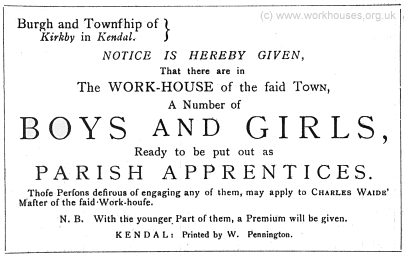
Kendal handbill, c.1820s.
In the township of Kirkland, at the south side of Kendal, a workhouse was established in 1809 at the head of what became Poor-House Lane, now Anchorite Place. The paupers were "farmed" by a contractor who was paid by the township.
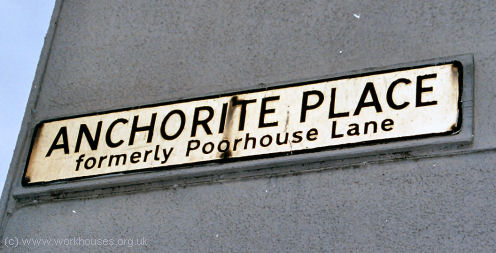
Poorhouse Lane, Kirkland, 2004.
© Peter Higginbotham.
Kirkby Lonsdale formed a Gilbert Union with sixteen other townships (in Westmorland: Barbon, Casterton, Firbank, Hutton Roof, Killington, Middleton, and Old Hutton; in Lancashire: Arkholm with Cawood, Burrow with Burrow, Cantsfield, Leck, Melling with Wrayton, Tunstall, and Whittington; in Yorkshire: Burton in Lonsdale, and Thornton in Lonsdale). The union erected a workhouse in 1811 at a cost of £2,150.
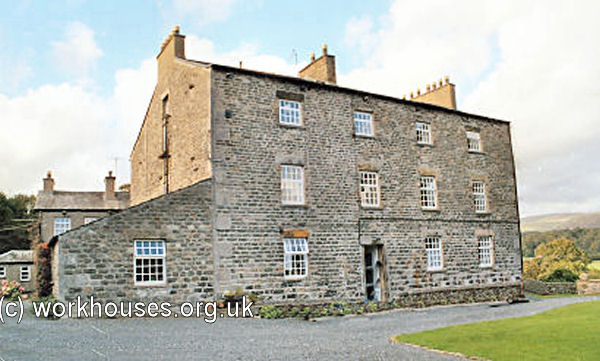
Kirkby Lonsdale former Gilbert Union workhouse, 2004.
© Peter Higginbotham.
Milnthorpe (or Milnthorp) with its close neighbour Heversham also formed a Gilbert Union in conjunction with fifteen other townships (in Westmorland: Beetham, Burton, Crook, Natland, Hincaster, Levens, Sedgewick, Stainton, Scalthwaite-Rigg with Hay, Underbarrow with Bradley-Field, and Witherslack with Ulpha; in Lancashire: Dalton and Yealand-Redmayne). In 1813, the union erected a workhouse at a cost of £4,990 and designed by Francis Webster of Kendal. Each township subscribed towards the building according to the average amount of their poor rates during the previous three years. According to an 1829 directory:
The house and garden occupy two acres, and, detached from the house, upon a pleasant eminence, is a fever ward, belonging to the institution. The whole is built on an excellent plan, and is well conducted by the Governor, Mr. John Rowes. The paupers grind all the corn used in the house at a small hand-mill, and many of them are employed in weaving coarse linen-cloths, checks, linsey-woolsey, &c. The Visiters and Guardians meet on the first Wednesday of every month, and the paupers are fed at the weekly cost of 2s. 4d. per head. George Wilson, Esq. of Dallam Tower, is the Visiter, and Mr. Wm. Bindloss, of Deepthwaite, the Deputy-visiter.
In 1829, the Windermere township of Undermillbeck erected a workhouse at the north side of Brantfell Road. The building was two storeys high, plus attics. The site was later occupied by a gas works.
After 1834
Kendal Poor Law Union formally came into being on 15th July 1836. Its operation was overseen by an elected Board of Guardians, 67 in number, representing its 57 constituent parishes and townships as listed below (figures in brackets indicate numbers of Guardians where not one):
Westmorland: Ambleside (2), Applethwaite, Barbon, Beetham, Burton, Casterton, Crook, Crosthwaite and Lyth, Dilicar, Docker, Farleton, Fawcett Forrest, Firbank, Grasmere, Grayrigg, Haverbrack, Helsington, Hincaster, Holme, Hugill, Hutton Roof, Kendal (7), Kentmere, Killington, Kirkby Lonsdale (2), Kirkland (2), Langdales, Lambrigg, Levens, Longsuddale, Lupton, Mansergh, Meethop and Ulpha, Middleton, Milnthorpe and Heversham (2), Natland, Nether Graveship, New Hutton, Old Hutton and Holmescales, Patton, Preston Patrick, Preston Richard, Rydal and Loughrigg, Scalthwaitrigg-Hay and Hutton'ith Hay, Sedgwick, Skelsmergh, Stainton, Nether Staveley, Over Staveley, Strickland Kettle, Strickland Roger, Troutbeck, Underbarrow and Bradley-field, Undermillbeck, Whinfell, Whitwell and Selside, Witherslack.
The population falling within the union at the 1831 census had been 26,906 with parishes and townships ranging in size from Fawcett Forrest (population 61) to Kendal itself (10,015). The average annual poor-rate expenditure for the period 1834-36 had been £12,728 or 7s.9d. per head of the population.
Kendal was somewhat unusual in that it permanently retained two pre-1834 parish workhouses, the one at Kendal and another at Milnthorpe. Kendal, which in 1849 could accommodate up to 335 inmates, catered for able-bodied men, and children over 7 years. Milnthorpe could house up to 300 and was used for the aged and infirm, infants, able-bodied women, and unmarried mothers. Some able-bodied women "of good character" were sent to Kendal as servants for the workhouse there. The old Kirkby Lonsdale workhouse is still shown as a workhouse on the 1859 OS map. It is thought to have operated mainly as a casual ward.
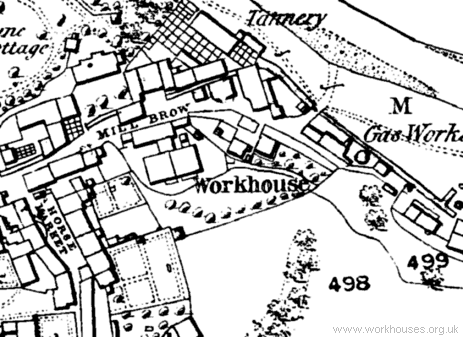
Kirkby Lonsdale site, 1859.
Kendal Workhouse
The Stricklandgate workhouse was built on a sloping site and had a somewhat irregular layout, the main part forming a U-shape open to the road at the south.
In 1861, Nicholson's Annals of Kendal described the workhouse as:
...a large, uniform building, two stories high, occupying three sides of a quadrangle, the fourth, which is the entrance, being open to the street. It contains, for the purposes of the paupers, one large general dining-room, kitchens, store-rooms, sick-rooms, &c. on the first floor ; and on the second floor thirty-five well-ventilated lodging-rooms, which contain eighty-nine good beds, supplied with sufficient comfortable clothing, and capable of accommodating two hundred persons ; together with suitable apartments appropriated to the use of the governor and his family. In the yard behind the Workhouse stands a commodious School-room for boys, and the contiguous building, which was formerly the harden manufactory, is, the lower part of it, appropriated as a play-ground, and the upper part is used for dormitories. What was formerly the Fever Ward is now occupied partly as a schoolroom for girls, and partly as girls' dormitories, with apartments for the schoolmistress. A productive garden is attached to the Workhouse, cultivated by the labour of the inmates.
The workhouse location and layout can be seen on the 1911 map below.
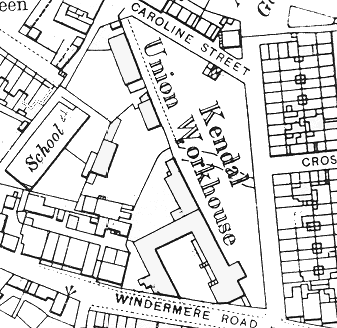
Kendal workhouse site, 1911.
The main wing at the east contained accommodation for the elderly and infirm, dining hall, stores and workshops. The cross wing contained the Master's quarters and office. The west wing included accommodation for the able-bodied and for "imbeciles" including a padded room. Additional small blocks to the north of the east wing probably included a vagrants' ward.
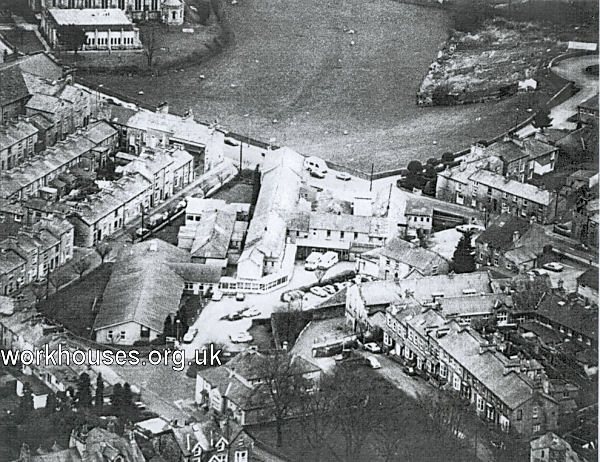
Kendal aerial view from the north, date unknown.
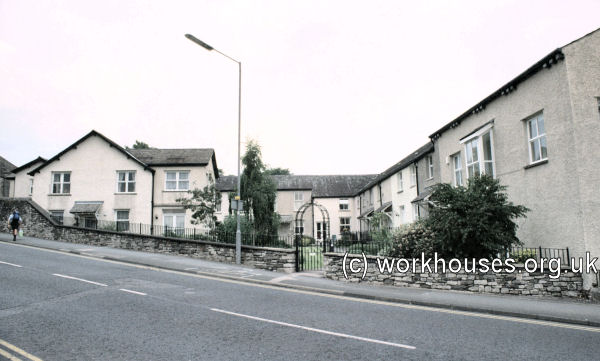
Kendal from the south, 2001.
© Peter Higginbotham.
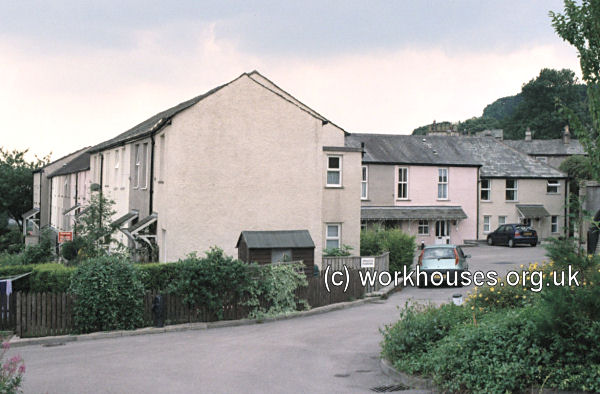
Kendal from the north, 2001.
© Peter Higginbotham.
Until the 1860s, children at the Kendal workhouse were all taught in the workhouse's own school-room. In 1865, female orphans were placed at the new orphan home on Milnthorpe Road established by Mary Howard of Levens Hall. The other girls then went out to a local school. For the boys, a military-style band was established.
Local people remember in the early 1900s groups of paupers sitting on Kendal Green breaking stones from the quarries. Huge stones were brought by cart and they sat there winter and summer. When it rained they covered themselves with sacks.
The Kendal workhouse later became Windermere Road Institution and after 1948 was known as Kendal Green Hospital. In 1970, following the closure of the hospital, some demolition took place. The surviving buildings have now been converted to housing known as Strickland Court.
Milnthorpe Workhouse
As noted above, the former Gilbert Union workhouse at Milnthorpe was retained by the Kendal Union for accommodating the aged and infirm, infants, able-bodied women, and unmarried mothers. The workhouse was situated at the east of Kirkgate Lane. Its layout is shown on the 1898 map below.
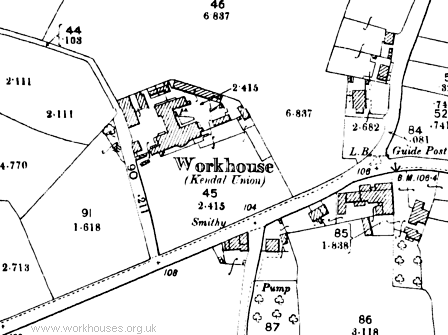
Milnthorpe workhouse site, 1898.
The site included a block at the south with a semi-hub at its centre — a relatively unusual feature in workhouses of this period but found at a few other places such as Caistor.
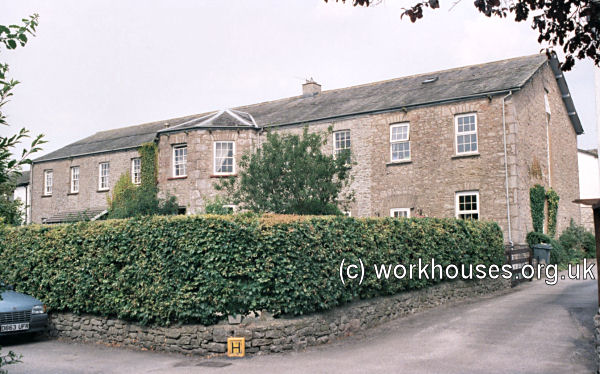
Kendal Milnthorpe workhouse main block from the south-east, 2001.
© Peter Higginbotham.
A central wing from its rear, now demolished, may have contained the workhouse dining hall and kitchens. A now much altered block at the north of the site was probably the infirmary erected in about 1865.
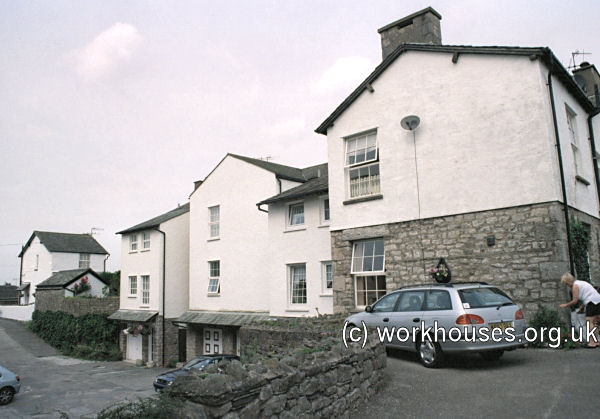
Kendal Milnthorpe workhouse from the south, 2001.
© Peter Higginbotham.
A single storey lodge at the west of the workhouse is dated 1869.
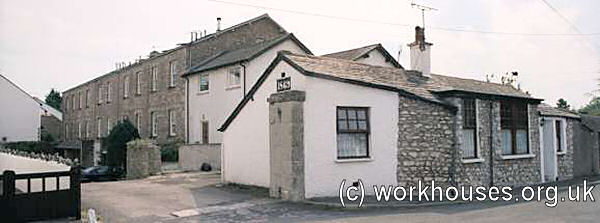
Kendal Milnthorpe lodge from the west, 2001.
© Peter Higginbotham.
In 1918, the site became Milnthorpe Hospital for the Mentally Subnormal, later Milnthorpe Hospital. The hospital closed in 1960 and the surviving buildings have now been converted for use as housing known as Chelsea Court.
Like many other northern manufacturing areas, Kendal found it difficult to operate the "workhouse or nothing" principle of relief enshrined in the 1834 Poor Law Amendment Act. Slumps in the local textile trade could lead to hundreds of handloom weavers suddenly in need of relief. This was more than the workhouses could cope with and would anyway have been very expensive for the Union - the cost of keeping someone in the workhouse was much more than giving them modest out-relief either as food or as a small cash payment. The weavers themselves were far from being totally destitute. What they wanted was short term relief which would allow them to continue with what little employment there was until times gradually improved.
Eventually, in 1848, the Poor Law Commission allowed the Kendal Guardians to operate an "outdoor labour test". This allowed the giving of relief to the able-bodied so long as they were prepared to undertake hard manual labour such as stone-breaking in a specially set up labour yard. Few were prepared to take this option and tried to scrape by as best they could. However, the plight of the weavers was much helped by the Kendal Fell Trust which had originally been set up to administer common land enclosed for the benefit of the poor at the start of the nineteenth century. The Trust also owned the workhouse site which they rented to the Kendal Board of Guardians. The Trustees used some of their funds to provide unofficial poor relief to the weavers. In 1862, they also took on the role of organising a programme of work for the able-bodied poor, for example in cultivating part of the land they owned.
The Abbey Children's Home, Staveley
In 1899, the Kendal Guardians acquired a property known as The Abbey in the village of Staveley for use as a children's home. The building could house up to 60 children.
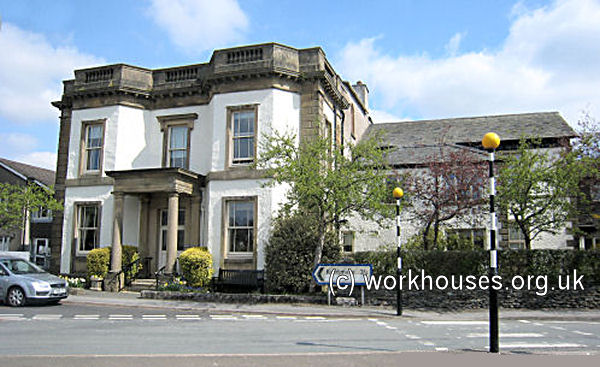
The Abbey Home, Staveley, 2010.
© Peter Higginbotham.
Staff
- 1881 Census - Kendal
- 1881 Census - Kendal Vagrants Ward
- 1881 Census - Milnthorpe
- 1881 Census - Milnthorpe Vagrants Ward
Inmates
- Long-term workhouse inmates (1861)
- 1881 Census - Kendal
- 1881 Census - Kendal Vagrants Ward
- 1881 Census - Milnthorpe
- 1881 Census - Milnthorpe Vagrants Ward
Records
Note: many repositories impose a closure period of up to 100 years for records identifying individuals. Before travelling a long distance, always check that the records you want to consult will be available.
-
Kendal Archive Centre, Kendal County Offices,
Kendal LA9 4RQ.
Holdings include: Guardians' minutes (1836-1930);
- Kendal: Deaths register (1836-48, 1914-38); register of lunatics (1885-1937); etc.
- Milnthorpe: Births register (1848-1914); etc.
- Kirkby Lonsdale: List of inmates and costs (1830); etc.
Bibliography
- John Curwen (1900) Kirkbie-Kendal
- Cornelius Nicholson (1861) Annals of Kendal
- RN Thompson (1978) The Working of the Poor Law Amendment Act in Cumbria, 1836-1871 in Northern History, Vol XIV.
- White, W. (1829) Directory and Gazetteer of Cumberland and Westmorland
Links
- None.
Acknowledgments
- Thanks to Elizabeth Ellis for contributing to this page.
Unless otherwise indicated, this page () is copyright Peter Higginbotham. Contents may not be reproduced without permission.


